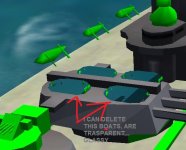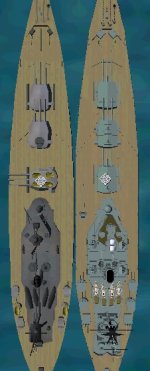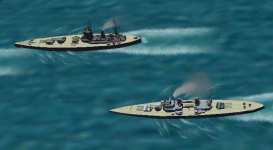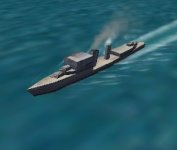[h=4]Protection[
edit][/h]
| Ship | Protection
(tons) | Protection
(%) | Displacement
(tons) | With fuel
(tons) | Fuel
load |
|---|
| Richelieu | 16,045
16,045 | 39.2
42.4 | (normal) 40,927
(standard) 37,832 | 2,905
– | 1/2
– |
| Dunkerque | 11,040 | 35.9 | (normal) 30,750 | 2,860 | 3/4 |
| Strasbourg | 11,785 | 37.3 | (normal) 31,570 | 2,860 | 3/4 |
| Iowa | 18,700 | 41.6 | (standard) 45,000 | | |
| Bismarck | 17,540
17,258 | 43.92
41.30 | (light) 39,931
(standard) 41,781 | | |
| King George V | 12,500 | 34.8 | (standard) 35,000 | | |
| Littorio | 13,600 | 36.03 | (standard) 37,750 | | |
On
Richelieu, the armor weight was 16,045 tonnes (15,792 long tons) and corresponded to 39.2% of the total weight, for a 40,927 tonnes (40,281 long tons) normal displacement, with 2,905 tonnes (2,859 long tons) of fuel (half of full load).[SUP]
[95][/SUP] The
Dunkerque had 35.9%, the
Strasbourg, 37.3%, with a 30,750 tonnes (30,260 long tons) or 31,570 tonnes (31,070 long tons) normal displacement, with 2,860 tonnes (2,815 long tons) of fuel (¾ of full load).[SUP]
[96][/SUP]
Comparison with other battleships is more intricate. The figures given for
Iowa-class battleships are 18,700 tons for armor weight or 41.6% of 45,000 tons standard displacement,[SUP]
[97][/SUP] which corresponds for the
Richelieu to more than 42% of standard displacement. For the
Bismarck, the figures are 17,258 tons or 17,540 tons of armor, and from 43.92% to 41.30%, depending on whether the percentage is calculated with 39,931 tons light displacement or 41,781 tons standard displacement.[SUP]
[53][/SUP][SUP]
[98][/SUP] All are higher than for earlier battleships (such as the
Dunkerque) or those for the
King George V-class battleships, 12500 tons and 34.80%[SUP]
[99][/SUP] or for the
Littorio-class battleships with 13,600 tonnes (13,400 long tons) weight of armor and 36% of 37,750 tonnes (37,150 long tons) standard displacement.[SUP]
[100][/SUP]
[h=5]Armor[
edit][/h]Armor thicknesses were:[SUP]
[101][/SUP]
- The armored belt, with a slope of 15°24’, was 327 mm (12.9 in) thick between frame 51.50 and frame 182.95 and from 3.38 meters (11.1 ft) above the waterline to 2.50 meters (8.2 ft) under the water line. The forward bulkhead, at frame 182.95, and the after bulkhead, at frame 51.50, extended from the main deck to the 30 mm (1.2 in) thick floor of the artillery magazines, and were 233 mm (9.2 in) thick. The forward bulkhead thickness increased to 355 mm (14.0 in) between the first and second platform decks.
- The upper armored deck at main deck level was 150 mm (5.9 in) thick above the machinery plant and was increasing to 170 mm (6.7 in) above the main artillery magazines. The lower armored deck was 40 mm (1.6 in) thick and extended to frame 233, improving the protection of the forward part of the ship, left unprotected on the Dunkerque. Abaft the after transverse bulkhead, (at the first platform deck level) was a 100 mm (3.9 in) armored deck with angled sides in the form of a carapace above the shafts, increasing to 150 mm (5.9 in) above the steering gear.
- On the conning tower, the armor was 340 mm (13 in) thick on the front and sides, 280 mm (11 in) on the rear' and 170 mm (6.7 in) on the roof.
- The main turrets were protected with 405 mm (15.9 in) thick armor on the barbette, above the upper armored deck, 430 mm (17 in) armor on the faces, inclined to 30°, from 170 mm (6.7 in) to 195 mm (7.7 in) on the roof, 270 mm (11 in) on the turret I rear wall and 260 mm (10 in) on the turret II rear wall. This thickness on the rear walls, less than the Dunkerque or Strasbourg's approximately 345 mm (13.6 in) thickness, was due to the use of a cemented steel on the Richelieu.
- The 152 mm (6.0 in) gun turrets were less armored than the Dunkerque quadruple 130 mm (5.1 in) turrets, with a 100 mm (3.9 in) thickness on barbettes, 130 mm (5.1 in) on the faces angled at 45°, 70 mm (2.8 in) on sides and roof, and 60 mm (2.4 in) on the rear.
The British
King George V-class battleships and
HMS Vanguard had a thicker armored belt than the
Richelieu (356 mm (14.0 in)), but their turrets were less protected (330 mm (13 in)), and the horizontal armor (152 mm (6.0 in)) was equivalent,[SUP]
[102][/SUP] but their command spaces were only protected against shrapnel.[SUP]
[103][/SUP]
The U.S. Navy battleships had an equivalent armored belt (about 335 mm (13.2 in)) to the
Richelieu, on the
North Carolina and
South Dakota classes, and a little less thick (310 mm (12 in)) on the
Iowa class. The main artillery turret protection was less thick (406 mm (16.0 in)) on the
North Carolina class, thicker (500 mm (20 in)) on the
Iowa class, and thicker (457 mm (18.0 in)) on the
South Dakota class. The horizontal armor was a little less thick (104 mm (4.1 in)) on the
North Carolina class and equivalent (127 mm (5.0 in) to 165 mm (6.5 in)) on the
South Dakota and
Iowa classes. The conning tower was better protected, with 406 mm (16.0 in) on the
North Carolina and
South Dakota classes and with 445 mm (17.5 in) on the
Iowa class.[SUP]
[104][/SUP]
The Italian
Littorio had a thicker armored belt (350 mm (14 in)) than the
Richelieu, but otherwise they were less protected, with 350 mm (14 in) on the main artillery turrets, 260 mm (10 in) on the conning tower, 50 mm (2.0 in) on the upper armored deck and 100 mm (3.9 in) on the main deck.[SUP]
[105][/SUP] The German
Bismarck-class battleships had a thinner armor than the
Richelieu on the main artillery turrets (356 mm (14.0 in)), but thicker on the conning tower (356 mm (14.0 in)), and equivalent for the armored belt (320 mm (13 in)) and horizontal armor (80 mm (3.1 in) to 115 mm (4.5 in)).[SUP]
[51][/SUP]





